How to Make Perfect Creamy Risotto: Your Ultimate Step-by-Step Guide
Unlock the secrets to crafting a truly magnificent risotto with this comprehensive guide. Risotto, a classic Italian dish, is renowned for its incredibly creamy texture, rich flavor, and versatility. Far from being an intimidating culinary challenge, it’s an enjoyable process that rewards patience with a truly delicious outcome. Learn the fundamental technique, master the art of stirring, and discover how to personalize this adaptable dish with your favorite proteins, seasonal vegetables, and aromatic herbs. Once you grasp the basics, you’ll be able to create endless variations, making risotto a staple in your home kitchen!

My Journey to Risotto Mastery
Almost a decade ago, when I first launched Cake ‘n Knife, I set myself a culinary challenge: to master the art of making risotto. I can’t quite pinpoint why this particular Italian dish captivated my imagination, but it became a significant milestone in my journey back into the kitchen. The mere thought of achieving that signature creamy texture felt like climbing a delicious mountain.
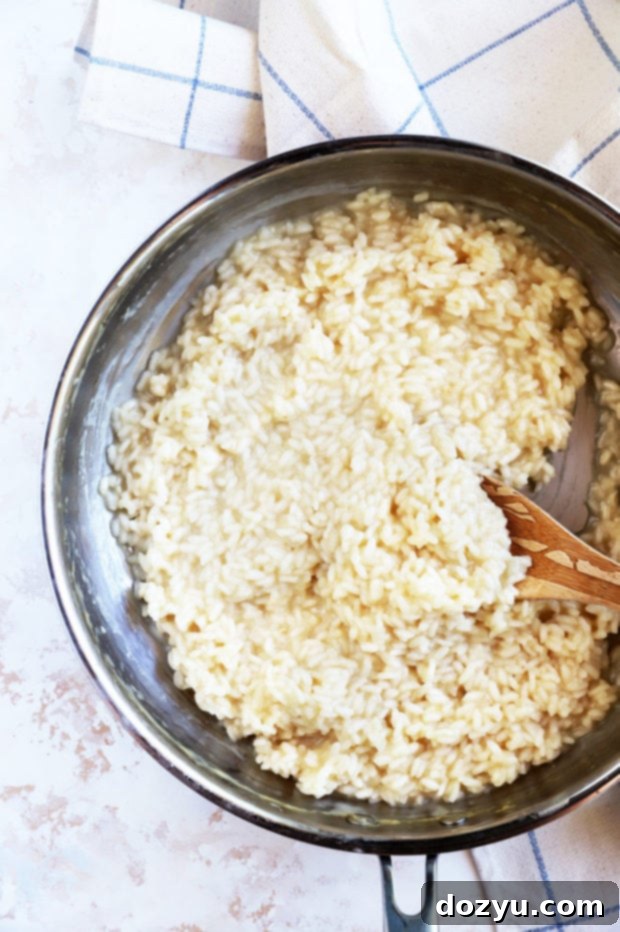
You can imagine my sheer delight when, on my very first attempt, it emerged from the skillet not just edible, but truly DELICIOUS. The rich, velvety texture was pure culinary bliss, inspiring me to make risotto repeatedly in the months that followed. Each batch solidified my technique and deepened my appreciation for this humble yet elegant dish.
Now, I’m thrilled to share my tried-and-true method for making risotto. While it might seem a little intimidating at first glance, I promise you, it’s far less complicated than you might think. The key to a fantastic risotto lies in a bit of time and mindful attention. So, before you begin, perhaps pour yourself a glass of wine – you’ll be cooking with it anyway! Put on some of your favorite music, or invite a loved one into the kitchen for a chat. Savor the process, breathe in the wonderful aromas filling your home, and infuse that skillet of creamy deliciousness with your love and care. This isn’t just cooking; it’s an experience.
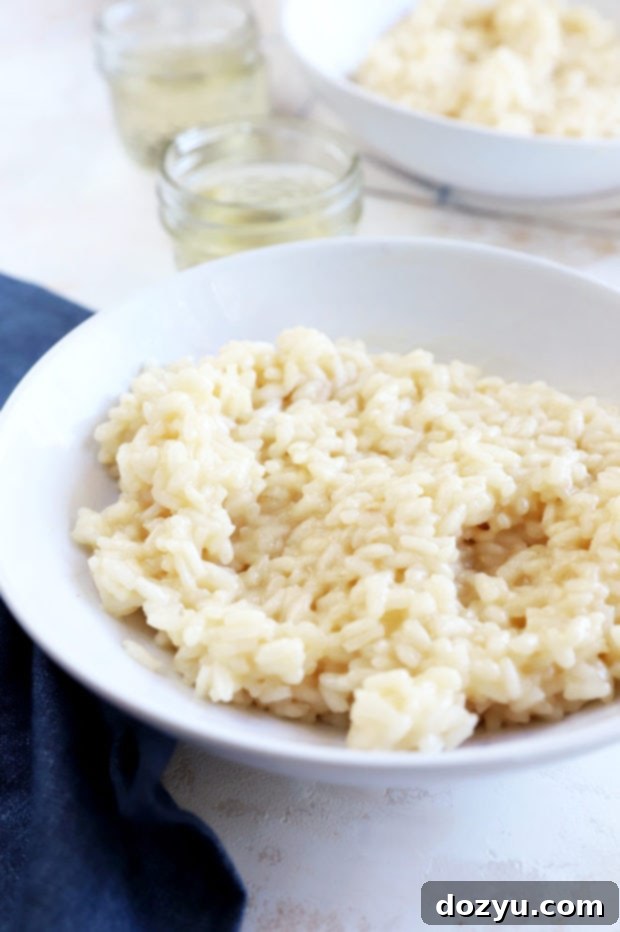
Essential Ingredients for Classic Parmesan Risotto
To embark on your risotto journey, you’ll need a few key ingredients. While the basic recipe for Parmesan risotto is simple, the quality of your ingredients significantly impacts the final flavor. Aim for high-quality chicken or vegetable stock, fresh Parmesan cheese, and, most importantly, the right type of rice.
Customizing Your Parmesan Risotto: Endless Possibilities
One of the most appealing aspects of risotto is its incredible adaptability. While a simple Parmesan risotto is divine on its own, it also serves as a perfect canvas for countless flavor combinations. Here are some delightful ways to personalize this classic dish:
- For a Heartier Flavor Profile: Instead of dry white wine, experiment with a good quality red wine. This imparts a deeper, more robust flavor and a beautiful color, ideal for mushroom or beef-based risottos.
- Luxurious Finishing Touch: Drizzle a small amount of high-quality truffle oil over your finished risotto just before serving. The earthy, aromatic notes of truffle elevate the dish to gourmet status.
- Add Savory Crunch: Stir in crispy bits of prosciutto or bacon at the very end. Their salty, smoky flavor and satisfying texture provide a wonderful contrast to the creamy rice.
- Fresh Herb Infusion: Incorporate your favorite fresh herbs. Finely chopped basil, thyme, rosemary, or oregano can be stirred in during the final minutes of cooking, or used as a fresh garnish, adding bright, aromatic notes.
- Seasonal Vegetable Boost: Chop up some vibrant vegetables and stir them in. Delicate vegetables like spinach or peas can be added in the last few minutes, while heartier ones like asparagus (blanched first) or roasted butternut squash can be folded in at the end.
- Tomato Tang: For a touch of acidity and umami, stir in a spoonful of tomato paste during the rice toasting stage, or incorporate sun-dried tomatoes (chopped) with the final additions.
- Embrace the Seasons: Think seasonally! In spring, add fresh asparagus and peas. In summer, sweet corn and cherry tomatoes are fantastic. Fall calls for earthy mushrooms and butternut squash, while winter can feature roasted root vegetables.
Looking for the perfect main course to complement your creamy risotto? Explore these fantastic pairings: Baked Lemon Garlic Salmon | Roasted Chicken with White Wine and Herbs | Grilled Salmon with Charred Corn Salsa | Grilled Avocado Caprese Chicken
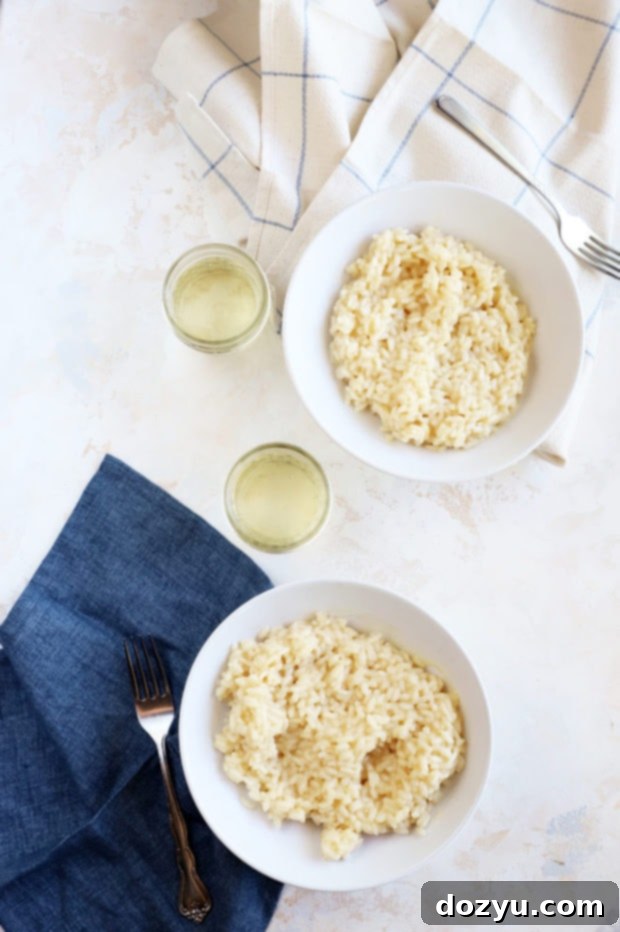
Must-Have Equipment for Risotto Success
While you don’t need a professional kitchen, a few key pieces of equipment can make your risotto-making experience much smoother and more enjoyable:
- Large High-Sided Skillet or Dutch Oven: I highly recommend a large high-sided skillet (or a Dutch oven) like the one mentioned in the recipe card. Its tall sides help contain the splattering liquid while you stir, and the wide surface area promotes even cooking and evaporation. It’s the perfect size for this recipe and can even accommodate a doubled batch.
- Wooden Spoon: A sturdy wooden spoon is essential for stirring. It won’t scratch your nonstick surfaces and is comfortable for the continuous stirring required. You’ll be stirring for a bit, so a good grip is a bonus!
- Small Saucepan: For warming your stock. This is a crucial step for achieving the perfect creamy texture.
- Ladle: To accurately measure and add stock to the rice.
The Art of Making Risotto: A Step-by-Step Guide
Follow these four simple yet crucial steps to achieve a perfectly creamy and flavorful risotto every time:
1. Warm the Stock
The first and often overlooked step is to warm your chicken (or vegetable) stock. Pour the stock into a small saucepan and bring it to a gentle simmer over medium heat. You don’t need a rolling boil, just a consistent warmth. Keep it covered and on low heat while you start the risotto. This warm liquid is vital for the rice to cook evenly and release its starches properly, leading to that coveted creamy consistency.
2. Toast the Rice (Soffritto)
Heat a large, high-sided skillet or Dutch oven over medium heat with olive oil. Once the oil shimmers, add the minced garlic and cook for about 30 seconds to 1 minute, until fragrant and lightly browned. This aromatic base is called the “soffritto” and is the foundation of your risotto’s flavor. For even more depth, you can add finely chopped onion or shallots with the garlic and cook until softened. Next, add the Arborio rice to the skillet. Stir constantly for about 2 minutes, allowing the rice grains to lightly toast. This process, known as “tostatura,” helps seal the outer layer of the rice, preventing it from becoming mushy and ensuring a pleasant al dente bite in the finished dish.
3. Cook and Stir: The Risotto Method
Pour in the white wine and continue to simmer, stirring occasionally, until the liquid is almost completely evaporated and absorbed by the rice. This step deglazes the pan and infuses the rice with a lovely acidity. Once the wine is absorbed, begin adding the warm stock, one ladle (about 1 cup) at a time. After each addition, stir the rice constantly until the stock is almost entirely absorbed. This continuous stirring is not merely busywork; it’s the magical key to risotto’s creaminess. The friction of the rice grains rubbing against each other, combined with the warm liquid, encourages the Arborio rice to release its natural starches, creating a velvety, emulsified sauce around each grain.
Repeat this process of adding one cup of stock and stirring until absorbed. Be attentive! You may not need to use all the stock. Towards the end of the cooking time (usually 25 to 35 minutes total), start taste-testing the rice after each addition. The rice should be tender but still have a slight bite in the center – this is the perfect “al dente” texture. Remove the skillet from the heat as soon as it reaches this stage.
Remember, you can use either chicken stock or chicken broth for this recipe, or even vegetable broth for a vegetarian option.
4. Finish with Flavor (Mantecatura)
Once the rice is perfectly al dente and creamy, stir in the grated Parmesan cheese and unsalted butter. Continue stirring until the cheese is fully melted and the butter is incorporated, adding a final layer of richness and gloss to your risotto. This step is called “mantecatura.” Season generously with kosher salt and freshly ground black pepper to taste. For a beautiful presentation and a burst of fresh flavor, garnish your finished risotto with fresh herbs like finely chopped parsley or thyme. Serve immediately, as risotto is best enjoyed fresh off the stove.
Hungry for more dinner inspiration? Discover a wealth of ideas on my mains recipe page!
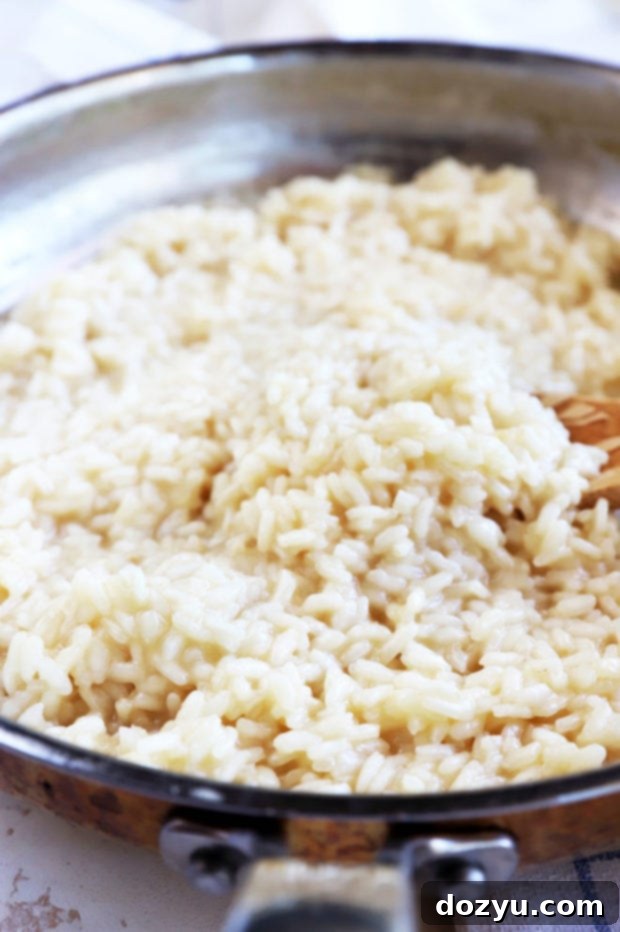
Risotto FAQs: Your Questions Answered
Do I need to warm up the stock?
Yes, warming the stock is a crucial step and truly makes a difference in your final risotto! Adding cold stock to hot rice will shock the grains, slowing down the cooking process and potentially preventing the rice from releasing its starches evenly. Warm stock, maintained at a low simmer, ensures a consistent cooking temperature, encourages optimal starch release, and contributes to that desirable creamy texture and faster cooking time.
Can you use regular rice for risotto?
For the best results and traditional creamy texture, you should always use a short-grain, high-starch rice specifically designed for risotto, such as Arborio rice, Carnaroli, or Vialone Nano. These varieties have a high amylopectin content, which is the type of starch that breaks down and creates the creamy sauce. Long-grain rice, like basmati or jasmine, has much less starch and will not yield the same creamy, luxurious consistency; it will likely result in a drier, separate-grained dish. While technically you *can* make something akin to risotto with long grain rice, it requires significantly more constant stirring and still won’t have the classic texture. If Arborio is unavailable, opt for Carnaroli, often considered the “king of risotto rice” for its superior starch content and resistance to overcooking.
What protein would you pair with risotto?
Risotto is incredibly versatile and pairs beautifully with a wide array of proteins. It can be served as an elegant side dish or transformed into a hearty main course by incorporating the protein directly. For a main dish, consider stirring in crispy bacon or prosciutto, sautéed shrimp, tender scallops, or sliced cooked Italian sausage. As a side, risotto complements roasted chicken, pan-seared duck breast, grilled steak, or baked salmon wonderfully. You can also simply serve slices of perfectly cooked steak or chicken directly on top of the risotto in the bowl for a rustic yet refined presentation.

Can I use vegetable broth to make it vegetarian?
Absolutely! Using a good quality vegetable broth is an excellent way to make your risotto vegetarian. Ensure the broth has a rich flavor, as it forms the backbone of the dish’s taste. You can also enhance the vegetarian version by adding sautéed mushrooms, leeks, or a medley of roasted vegetables.
Can I use water instead of chicken stock?
While you *can* technically use simmering water instead of chicken stock, be aware that your risotto will lack the depth and richness of flavor that stock provides. Stock adds a savory umami dimension that water simply cannot replicate. If you’re out of stock, water is an option, but consider fortifying it with some herbs, a touch of bouillon, or even a splash of wine to boost the flavor profile.
Can I make it ahead of time?
Risotto is best enjoyed fresh, immediately after preparation, as its creamy texture begins to stiffen as it cools. However, if you must make it ahead, refrigerate it promptly in an airtight container for up to two days. Do not freeze risotto, as the rice texture will become unpleasantly mushy upon thawing.
To reheat, the goal is to restore its creaminess without overcooking the rice. Add about 1 tablespoon of unsalted butter and a splash of white wine or additional chicken stock to the cold risotto. Microwave it for 2-3 minutes, stirring halfway through. Check the temperature and consistency; you may need to microwave longer or add more liquid to achieve your desired creaminess. Stir vigorously to re-emulsify the starches.
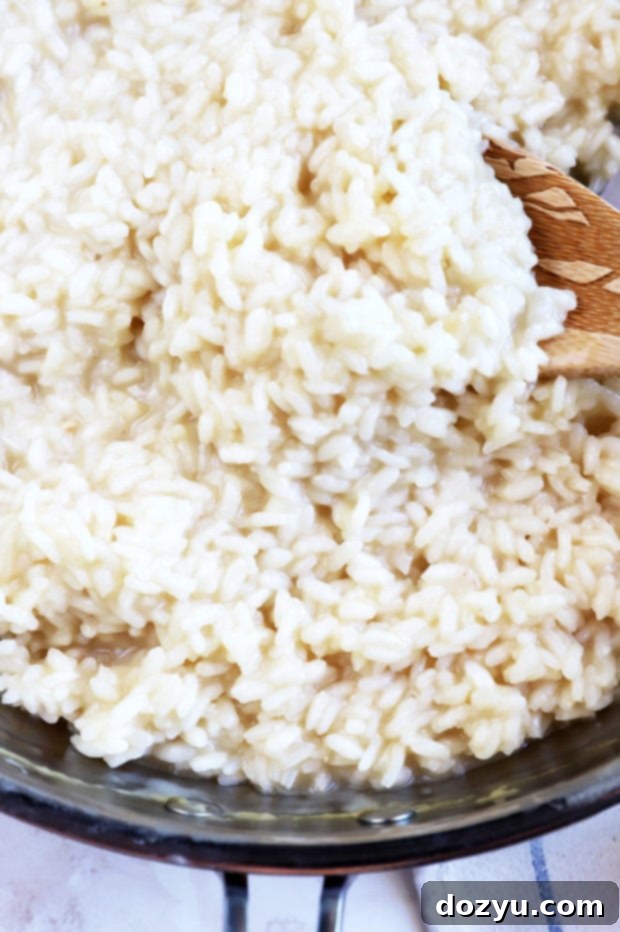
Discover Seasonal Risotto Recipes
Risotto is a dish that truly shines when infused with seasonal ingredients. I love creating variations that celebrate the best produce each time of year has to offer. Here are some of my favorite seasonal risotto recipes to inspire your next meal:
- For a taste of spring, my creamy risotto with asparagus and peas is light, bright, and incredibly fresh. The delicate flavors perfectly capture the essence of the season.
- During summer, I often turn to grilling! My summer corn tomato risotto features sweet, charred corn and juicy tomatoes, bringing vibrant, sun-kissed flavors to your plate.
- As autumn arrives, cozy up with a comforting bowl of my bacon butternut squash risotto. The sweet earthiness of butternut squash paired with savory bacon and fresh sage makes this an absolute seasonal favorite of mine.
- When winter’s chill sets in, my winter roasted vegetable risotto becomes a go-to. It’s packed with hearty, oven-roasted root vegetables, offering warmth and robust flavors perfect for colder months.
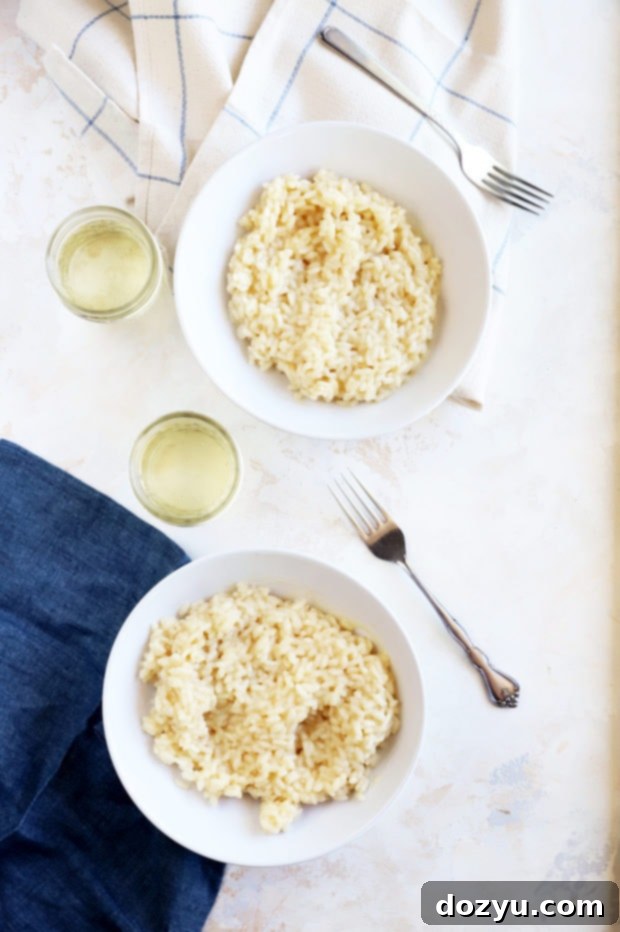
Simple Parmesan Risotto
Equipment
-
Le Creuset Saucepan
-
Pyrex Prepware Measuring Cups
-
Wooden Spoon & Scraper
-
Nonstick 12-Inch Skillet
Ingredients
- 2 to 3 cups chicken stock
- 1 Tbsp olive oil
- 2 garlic cloves minced
- 1 cup arborio rice
- 1 cup dry white wine I used a chardonnay, but Pinot Grigio also works well
- 1/4 cup grated parmesan cheese
- 1 Tbsp unsalted butter
- Kosher salt and freshly ground black pepper to taste
- Fresh parsley or thyme for garnish, optional
Instructions
-
Prepare the Stock: In a small saucepan, bring the chicken stock to a gentle simmer; cover and keep warm over low heat. This ensures the stock is ready to be gradually added to the rice without cooling it down.
-
Toast the Rice: In a large, high-sided skillet (or Dutch oven), heat olive oil over medium heat. Add the minced garlic and cook until fragrant and lightly browned, about 30 seconds to 1 minute. Stir in the Arborio rice and toast for approximately 2 minutes, ensuring the grains are lightly coated in oil and just beginning to turn translucent at the edges.
-
Deglaze and Cook: Pour in the white wine and simmer, stirring constantly, until the liquid is almost completely evaporated and absorbed by the rice. This step deglazes the pan and imparts a lovely flavor. Next, begin adding the hot stock, about 1 cup at a time. Cook, stirring constantly, until each addition of stock has been fully absorbed by the rice before adding the next. Repeat this methodical process, adding 1 cup of stock at a time and stirring patiently until the rice is tender with a slight al dente bite. You may not need all the stock, so taste the rice between each addition to check for doneness. This entire cooking process should take approximately 25 to 35 minutes total.
-
Finish and Serve: Once the rice is perfectly cooked, remove the skillet from the heat. Stir in the grated Parmesan cheese and unsalted butter until both are completely melted and integrated, creating a luxurious, creamy consistency. Season generously with kosher salt and freshly ground black pepper to taste. Keep warm over low heat until ready to serve, or serve immediately for the best texture. Garnish with fresh parsley or thyme if desired.
